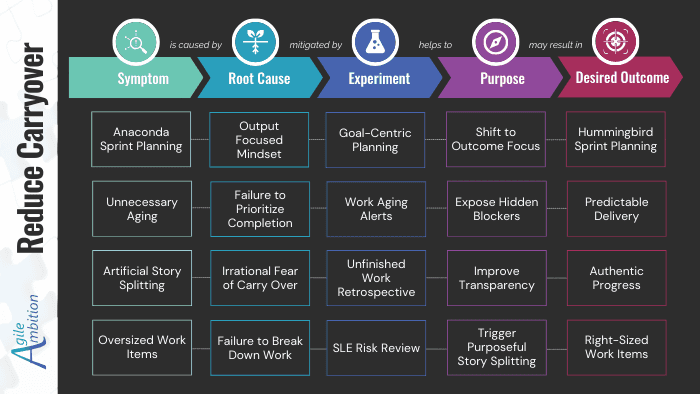Regulating the Rhythm: Reduce Carryover

Carryover is your Sprint’s faltering heartbeat, exposing deeper issues that disrupt delivery and erode trust. Just like a steady heartbeat builds confidence in health, a predictable delivery rhythm instills confidence in your team.

Does carryover leave your team feeling like they’ve flunked the Sprint? You’re not alone. Remember, just like a skipped heartbeat doesn’t mean you’re heading for a heart attack, unfinished stories aren’t always a crisis.
But like an irregular heartbeat, you can’t ignore it and hope for the best. Tackling carryover improves predictability— and with that, trust falls right into place.
Let’s dive into four experiments that can help you piece together how to reduce carryover and get your team’s rhythm back on track.
From Anaconda Sprint Planning to Hummingbird Sprint Planning

Maarten Dalmijn outlines two approaches to Sprint Planning I’ve seen countless times but never truly internalized. Like an anaconda, the first is all about stuffing the Sprint with as much work as possible—ensuring no one’s “idle.” The other focuses on a single outcome: bring in what’s needed to achieve the goal, then pick up more if time allows. How does this relate to carryover? If your Sprint starts packed to the brim, you’re setting yourself up to fail. Experiment with goal-centric planning and shift your focus from completing every backlog item to achieving the Sprint Goal. Leave room for the unexpected.
Goal-Centric Planning empowers your team to prioritize outcomes.
🤔 What would change if your team prioritized Sprint Goals over task completion in your planning sessions?
From Unnecessary Aging to Predictable Delivery

We all have that one task we avoid, like the dentist. Productivity gurus call the strategy for tackling it “eating the frog”—knocking out the dreaded task first to get it off your plate. Your team might face similar roadblocks. Some stories linger half-finished, never crossing the finish line. Maybe they involve too much back-and-forth, or the requirements are fuzzy. Experimenting with work aging alerts for items breaking their SLE can help bring these neglected tasks back into focus so they can get the attention they need to wrap up. Exposing hidden impediments paves the way for smoother, more predictable delivery.
Work Aging Alerts expose hidden blockers, helping teams address stalled work early and improve delivery predictability.
🤔 What strategies can you implement to ensure neglected work gets the attention it needs to be completed?
From Artificial Story Splitting to Authentic Progress

Treating the Sprint as an arbitrary deadline and the Sprint Backlog as a commitment drives some teams to take shortcuts. One tactic? Marking a story as “done” even when it’s not. Sure, it violates the definition of done, and users won’t see the value, but hey—at least there’s no carryover at the end of the Sprint, right? But this doesn’t just go against the Spirit of Scrum; it robs you of the chance to learn. Try an Unfinished Work Retrospective instead. Dig into why you didn’t finish the items, identify patterns, and brainstorm solutions. Fix the root cause, don’t just sweep it under the rug. You’ll improve transparency and feel better about making authentic progress.
Unfinished Work Retrospective uncovers root causes of carryover, helping teams identify patterns and improve future planning.
🤔 What shortcuts does your team take to avoid carryover, and how do they impact transparency?
From Oversized Work Items to Right-Sized Work Items

Do you know the number one reason teams struggle with carryover? They fail to right-size work items. They bring in massive stories, assume they’ll “figure it out,” and skip over the tough conversations needed to understand what it’ll really take. I saw a great example in a #NoEstimates video. How long would it take if I asked you to write your name on an index card with a blue fountain pen? You might have a guess, but did you assume you already had the index card? Was it the right size? Did you think the pen wrote in blue ink? Try approaching all stories as if they’re traps. Experiment with an SLE Risk Review to catch hidden risks and trigger purposeful splitting.
SLE Risk Review helps teams identify potential pitfalls early, enabling purposeful story splitting and ensuring predictable delivery.
🤔 How often does your team bring in large, ambiguous stories without fully understanding the work involved?
TLDR;
Carryover, like the occasional skipped heartbeat, can’t be avoided entirely. Not every beat will be perfectly in sync. The key is to strike a balance between ignoring issues and overreacting. Aim to keep as many beats steady as possible—get most of your stories over the line—and the few that slip through are less likely to be fatal.

Start experimenting today—your team will thank you.
Share
Table Of Contents
Fuel an Idea
Every week, I break down complex ideas, strip away the fluff, and give you experiments to turn knowledge into skills.
If that’s worth a coffee, consider fueling the next big insight.
No pressure. No guilt trips. Just impact.
Buy Me a CoffeeRelated Posts
Quick Links
Legal Stuff

